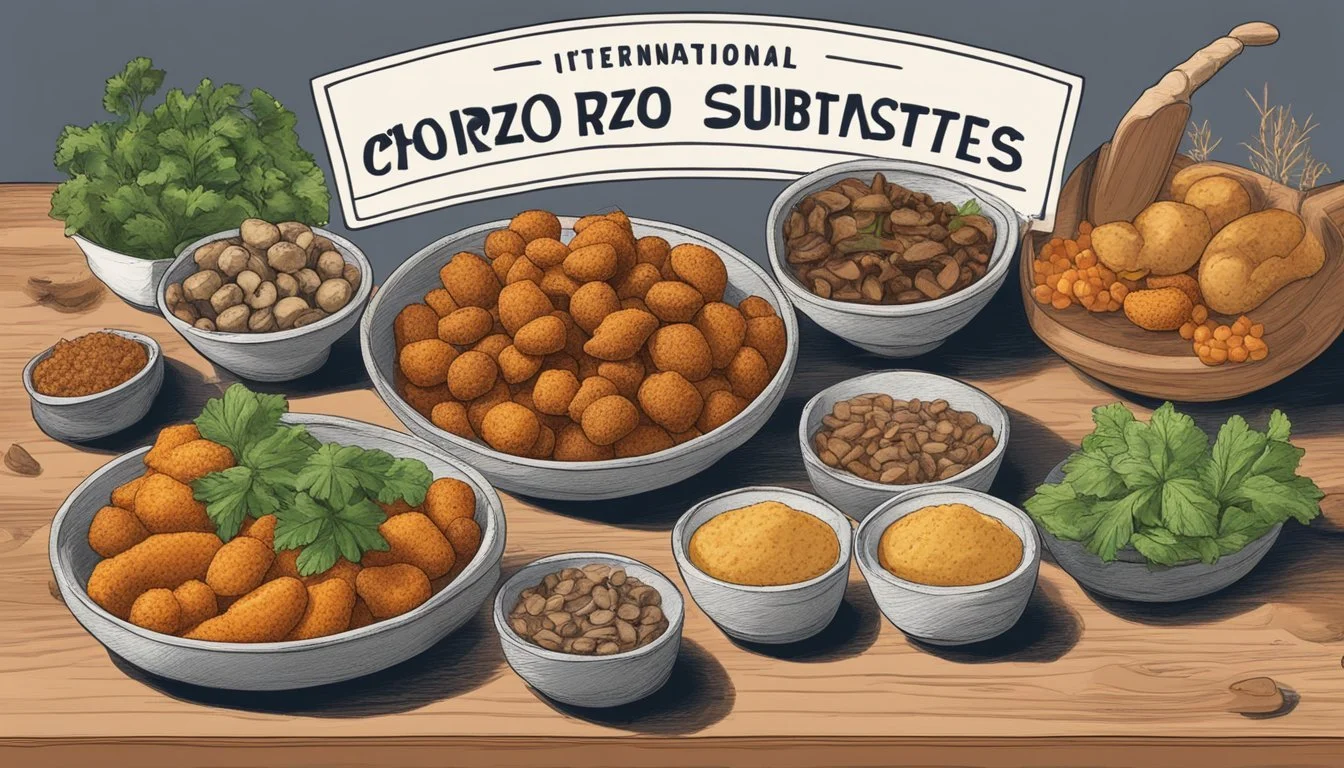Chorizo Substitutes
Top Alternatives for Your Recipes
Chorizo, a type of pork sausage originating from Spain and popular in Mexican cuisine, is known for its deep, smoky flavor and hints of spiciness which makes it a distinct and sought-after ingredient in various dishes. However, there are times when chorizo may not be readily available or suitable for all dietary preferences or restrictions, necessitating the need for substitutes that can mimic its characteristic taste and texture.
When looking for alternatives to chorizo, individuals can consider several other meats seasoned appropriately, or even non-meat options that are crafted to replicate the sausage's flavor profile. Ground pork is a common starting point, as it can take on a similar consistency to chorizo when cooked; blending it with spices such as paprika, garlic, and chili powder enhances its taste to better resemble chorizo's typical smokiness and warmth. Additionally, vegan options that use soy protein combined with a mix of spices offer a plant-based solution without sacrificing the distinctive flavor that chorizo brings to a dish.
Understanding Chorizo
Chorizo is a distinctive type of sausage known for its deep red color and a bold, spicy flavor profile that makes it a staple in various cuisines.
Types of Chorizo
Mexican Chorizo is typically sold fresh and uncooked, with a loose, crumbly texture similar to that of raw ground pork. It's often used in tacos, burritos, and other traditional Mexican dishes. Spanish Chorizo, on the other hand, is generally cured or smoked, featuring a firm and sliceable consistency. They are not directly interchangeable due to their textural differences and the preparation methods required for each.
Mexican Chorizo: Usually made with fresh ground pork, seasoned with local spices.
Spanish Chorizo: Often made from smoked pork, with variations such as fresh chorizo or dry chorizo akin to salami.
Key Flavors of Chorizo
The primary flavors in chorizo derive from a robust spice blend, highlighting:
Garlic: A key ingredient for its potent and aromatic qualities.
Paprika: The backbone spice of chorizo, providing warmth and color; often found in two forms:
Sweet Paprika: Milder in spice, used for a round flavor.
Smoked Paprika: Infuses a smoky essence, especially prevalent in Spanish varieties.
Traditional Chorizo Ingredients
The base ingredients for making chorizo are finely ground pork and a mix of spices for seasoning. The signature red hue comes from the liberal use of paprika. Other spices may include chili powder and cumin, especially in Mexican varieties, to enhance the piquancy of the sausage.
Meat: Pork is traditional, but variations exist.
Seasonings: Paprika is essential, with garlic and other regional spices completing the profile.
Animal-Based Chorizo Substitutes
When seeking alternatives to chorizo, one can find a variety of animal-based substitutes that can mimic its rich flavors and textures. These substitutes are often more accessible and can be adapted to meet similar taste profiles through seasoning and cooking methods.
Pork-Based Substitutes
Ground Pork: This is a versatile base that can be seasoned to closely match chorizo's flavor. One could add a blend of paprika, garlic, and chili powder to ground pork to achieve a similar taste.
Bacon: As a fatty, smoked pork product, bacon can replicate chorizo's smokiness when added with smoked paprika.
Italian Sausage: Available in sweet and spicy varieties, Italian sausage can fill in for chorizo by providing a similar depth of flavor, especially when additional spices are used.
Andouille: A smoked sausage typically used in Cajun cooking, andouille can substitute Mexican chorizo by adding a complex, spicy flavor profile to dishes like gumbo and jambalaya.
Beef-Based Substitutes
Beef can serve as a heartier option for those preferring a different meat type while maintaining the essential characteristics of chorizo.
Ground Beef: While leaner than pork, ground beef can be used as a substitute when seasoned with traditional chorizo spices, such as paprika, garlic, and a hint of vinegar for tanginess.
Poultry-Based Substitutes
Poultry offers a lighter, leaner choice and can be utilized to create a chorizo-like experience when properly seasoned.
Chicken Sausages: For a healthier alternative, chicken sausages can be used. They often come pre-seasoned but can be further enhanced with additional chorizo-like spices.
Turkey Sausages: Similarly to chicken sausages, turkey sausages can be a substitute, especially when one wants to reduce red meat intake without sacrificing the flavor and texture of a sausage-based dish.
Meat Alternatives
When seeking alternatives to traditional chorizo, there are both vegetarian and vegan options that provide similar flavors and textures. These meat-free choices offer a protein-rich base for dishes that traditionally include chorizo.
Vegetarian Sausage Options
Vegetarian chorizo substitutes typically utilize protein sources such as soy, eggs, or dairy to mimic the texture of meat. They may include:
Soy-based sausages: A popular choice, often seasoned with traditional spices such as paprika, garlic, and chili.
Chickpea sausages: Made from chickpeas, these sausages are less common but provide a robust texture and are high in protein.
It's worth noting that while these options are vegetarian, they may not be suitable for vegans.
Making Vegan Chorizo At Home
For a homemade vegan chorizo, individuals can create a mix that utilizes:
Tofu: A crumbled or mashed base with a texture similar to minced meat.
Spices: Key to achieving the characteristic flavor of chorizo, spices like cumin, chili powder, and paprika are crucial.
The mixture can be customized according to taste preference and the desired level of heat. Vegan chorizo ensures that the dish remains completely animal-free, catering to those adhering to a vegan lifestyle.
Chorizo Flavorings and Spices
Chorizo is distinguished by its robust, spicy profile, driven by a distinctive blend of seasonings. To replicate the chorizo experience, one must understand and utilize the key spices that contribute to its signature flavor.
DIY Chorizo Seasoning Mix
Creating a homemade chorizo seasoning mix allows for a customizable flavor profile. The core component is paprika, which imparts a sweet yet smoky character, establishing the primary tone of the chorizo. To this base, one should add cumin for its earthy warmth and chili powder for a touch of heat. Cayenne pepper can be adjusted according to the desired spiciness.
Oregano brings a subtle herbaceous note, while black pepper rounds out the mix with its piquant edge. Here's a simple table for reference:
Spice Note Quantity Paprika Sweet and smoky 2 tablespoons Cumin Earthy warmth 1 teaspoon Chili Powder Mild to moderate heat 1 teaspoon Cayenne Pepper Spicy heat 1/4 teaspoon Oregano Herbaceous 1 teaspoon Black Pepper Pungent spice 1/2 teaspoon
Common Spices for Chorizo Flavor
Individual spices may vary by region and tradition, but the recurring theme for an authentic chorizo flavor is a balance between smoky, spicy, and aromatic components. Paprika is non-negotiable in chorizo, providing the quintessential smoky flavor. The smoky characteristic of this spice is foundational to chorizo's identity.
Cumin and chili powder play indispensable roles, contributing complexity and a spicy kick integral to chorizo. Meanwhile, cayenne can be used sparingly to amplify the heat without overshadowing the other spices. Incorporating these spices in the right proportions ensures a close approximation to the traditional chorizo flavor.
International Chorizo Alternatives
When seeking alternatives to traditional Spanish chorizo, one can explore various international sausages that offer similar flavor profiles and textures. European sausages provide a range of flavors from smoky to savory, while Latin American varieties offer unique spice blends and meat combinations.
European Sausage Substitutes
Spanish Chorizo: Typically, Spanish chorizo is seasoned with paprika and garlic, offering a distinctive smoky flavor. Substitutes from Europe might include:
Andouille: A French sausage with a smoky, spiced flavor.
Salami: It offers a boldly savory taste and can serve as a ready-to-eat substitute.
Polish Kielbasa: Smokiness and mild spices, similar to chorizo, but usually less piquant.
Linguica: A Portuguese sausage, linguica is mildly smoky and garlicky, somewhat similar to mild Spanish chorizo.
Each European substitute should be chosen based on the desired flavor profile and texture, considering the regional spices and preparation methods that differentiate them from traditional Spanish chorizo.
Latin American Sausage Varieties
Mexican Chorizo: This Latin American version differs from Spanish chorizo, as it is usually made with fresh meat and has a more intense spice level with the inclusion of vinegar and chili peppers.
Pepperoni: Although not a traditional Latin American sausage, pepperoni carries a similar heat level and can fit well in recipes calling for spicy Mexican chorizo.
It is important to note that the consistency and fat content might vary, so one should adjust cooking times and methods accordingly. Latin American alternatives often emphasize bold spices and robust flavors, making them suitable replacements in a variety of dishes where chorizo is required.
Incorporating Substitutes in Dishes
When choosing substitutes for chorizo in various dishes, one must consider how the alternative complements the flavor profile and the desired heat level.
Recipes That Complement Chorizo Substitutes
For recipes such as stews, soups, and paellas, which traditionally feature chorizo, substitutes need to contribute a similar depth of flavor. In these cases, robust options like andouille sausage can be an excellent match due to its rich, smoky taste and compatibility with bold seasonings. For taco fillings or pasta sauces where chorizo's distinctive piquancy shines, ground pork seasoned with smoked paprika, garlic, and chili powder offers a milder yet flavorful alternative.
Stews and Soups: Andouille or Italian sausage (for a lighter flavor), with additional spices to match traditional chorizo.
Paella: Use pepperoni for a spicy kick, or ground pork with generous paprika to emulate chorizo's color and warmth.
Tacos and Pasta: Opt for ground pork or even bacon, fortifying with spices to achieve the desired taste profile.
Adjusting Heat and Spiciness
The heat level of chorizo substitutes can be adjusted according to personal preference. To mimic the heat of Mexican chorizo, consider adding chili powder or cayenne pepper to the substitute meat. For those seeking a milder taste, such as in some pasta dishes, one might reduce the amount of these spices or opt for milder paprika.
Increase Heat: Add cayenne pepper or red chili flakes to ground meats.
Milder Flavor: Use sweet paprika instead of hot, and adjust garlic and chili to a lower quantity.
When swapping out chorizo, chefs should taste and adjust spices continually, ensuring the substitute not only fits the dish but also appeases their unique flavor preferences.
Shopping for Chorizo Substitutes
When seeking alternatives to chorizo, shoppers should seek options that mirror chorizo's distinctive piquant and smoky flavor profile. Ideal substitutes can be found at both grocery stores and butcher shops, often requiring additional spices to match the taste of traditional chorizo.
Grocery Store Finds
At the local grocery store, one can find several convenient substitutes that can be enhanced with spices like smoked paprika and garlic to emulate chorizo's robust flavor. Products often include:
Ground Pork: A common base for DIY chorizo seasoning.
Enhance with 2 teaspoons of smoked paprika, 1 teaspoon of garlic powder, and a pinch of chili powder per pound of meat.
Turkey Sausage: A leaner option that also benefits from added spices.
Vegan Sausage: These plant-based sausages usually contain soy protein and are pre-seasoned with a blend of chorizo-like spices.
Butcher Shop Selections
Butcher shops may provide a more specialized selection, often with higher quality meats that can be used as chorizo substitutes:
Andouille Sausage: A good option for those who enjoy a smoky, spicy taste in dishes like gumbo or jambalaya.
Fresh Spiced Sausages: Butchers may carry sausages with a spice blend similar to chorizo's, often incorporating paprika and garlic into the mix.
Custom Spice Blends: Butchers might offer custom spice mixes that can be added to ground meats to recreate the chorizo flavor.
Shoppers should not shy away from adjusting the seasonings to suit their personal taste preferences, ensuring a suitable balance of savory and spicy notes characteristic of chorizo.
Health and Dietary Considerations
When selecting a chorizo substitute, considering the health and dietary implications is essential. Factors such as fat content, sodium levels, and potential allergens may influence your choice, depending on individual health needs or restrictions.
Low-Fat and Low-Sodium Options
For those seeking lower fat and sodium alternatives to Spanish chorizo, turkey sausage can be an effective substitute. It generally contains less fat and can be found with reduced sodium levels. To enhance the flavor profile to more closely resemble chorizo, one could incorporate spices such as paprika and garlic into a turkey sausage mixture.
Pork butt, also known as Boston butt, can be an alternative for making homemade chorizo. By trimming the excess fat and controlling the salt added during preparation, one can create a more health-conscious version.
Allergen-Friendly Choices
Individuals with dietary allergies, particularly to gluten which can be present in some sausage casing, might opt for casing-free sausage options or check labels for gluten-free certification.
Vegetarian alternatives to chorizo such as those made from tofu or other plant-based proteins, not only cater to vegetarian diets but can also provide allergen-friendly options. These substitutes often use soy protein combined with classic chorizo spices like cumin, smoked paprika, and chili powder to achieve a similar taste profile.
Note: Always review ingredient labels when purchasing substitutes to ensure they meet your specific dietary requirements.
Preservation and Storage
When it comes to preserving chorizo substitutes, understanding proper storage techniques for meat substitutes and seasonings ensures both safety and flavor retention.
Refrigerating Meat Substitutes
For curing meats such as cured pork sausage or dried sausage, refrigeration is essential. Cured meat, particularly those substituted for chorizo, should be kept in the refrigerator. To retain their flavor and prevent the meat from turning brown, one should:
Wrap the meat in parchment paper, followed by a tight layer of plastic wrap.
Store the meat in the coldest part of the refrigerator, typically at or below 40°F (4°C).
If the substitute is something like ground pork, consume it within two days for optimal freshness.
Slicing the sausage before refrigeration is not recommended unless it will be consumed quickly, as the cut surfaces can dry out or change in flavor more rapidly.
Long-Term Preservation of Seasonings
The spices and seasonings that give chorizo its distinctive flavor, such as sweet and spicy paprika, need careful storage to maintain their potency. For long-term preservation:
Keep seasonings in airtight containers away from heat and light.
Label the containers with the contents and the date it was stored.
Ground spices used to mimic chorizo flavors, such as cumin and chili powder, should not be kept longer than six months to a year for the best taste.
For those who wish to poach their chorizo substitutes in spices and herbs, it's crucial to let the meat cool completely before transferring to an airtight container and refrigerating. This method also infuses the meat more deeply with the desired chorizo-like flavors.
Preparing and Cooking with Substitutes
When substituting chorizo, achieving a balance between texture and flavor is crucial. Selecting the right ingredient and cooking technique ensures the substitute not only fits within the dish but also delivers a satisfying experience.
Cooking Techniques for Substitutes
Cooking techniques play a vital role in making substitutions work. For example, to replace chorizo with ground pork, chefs often employ a sautéing method, browning the meat thoroughly to develop a rich flavor. It’s important to add spices such as paprika, garlic powder, and chili powder to mimic chorizo’s distinct taste profile. When using bacon as a substitute, one should render it crisp to not only match the firm texture but to also infuse dishes with a smoky depth.
Andouille sausage is another robust alternative known for its suitability in dishes like gumbo and jambalaya. To prepare it, one should slice and brown it in a pan, allowing the bold spices and smoky flavor to shine through, akin to Mexican chorizo.
Matching Textures and Flavor Profiles
The texture and flavor profile of chorizo—a firm yet chewy sausage with a deep, complex flavor—can be matched with various substitutes:
Minced pork, when adequately spiced, can resemble the taste and texture of chorizo, with a tender yet substantial mouthfeel.
Pepperoni can achieve both a chewy texture and a spicy kick. It is sliced or diced then cooked until it releases its aromatic oils, blending well with other ingredients.
For a vegetarian rendition, soy-based vegan chorizo is seasoned with cumin, chili powder, and paprika to emulate the original's flavor and is typically cooked until it achieves a desired firmness.
In the table below are quick tips for matching these profiles:
Substitute Texture Flavor Cooking Suggestion Ground Pork Firm Mild, customizable Sauté with spices Bacon Chewy Smoky Render until crisp Andouille Firm, chewy Spicy, smoky Slice and brown Pepperoni Chewy Spicy Cook to release oils Vegan Chorizo Variable Earthy, spicy Cook to desired firmness
By understanding the characteristics of these substitutes, one can confidently recreate the essential qualities of chorizo in their culinary endeavors.
Presentation and Serving
When using chorizo substitutes in culinary presentations, the focus should be on maintaining the visual appeal and taste compatibility of the dishes they complement. Proper integration into charcuterie (What wine goes well with charcuterie?) and attention to garnishing can enhance the overall dining experience.
Integrating Substitutes into Charcuterie
For charcuterie boards, a key element is a variety of textures and flavors. Andouille sausage, with its rich taste, can replace Mexican chorizo and pairs well with a variety of cheeses and pickled vegetables. When using ground pork as a substitute, chefs enhance its flavor by adding spices such as paprika, garlic, and chili powder to mimic chorizo's punch. The presentation on a charcuterie board can be elevated with:
Sliced sausage placed alongside complementary flavors.
A sprinkle of fresh herbs for added color and aroma.
A drizzle of wine vinegar on the sausage slices to cut through the fats and enliven the palate.
Garnishing and Plating Tips
The presentation of a dish featuring chorizo substitutes should tell a story of both the original and the new ingredient. When serving tapas, using ingredients like vegan chorizo made from soy protein can provide a similar aesthetic to traditional chorizo when crumbled and garnished with:
Paprika for color and smokiness.
Chopped parsley or cilantro for a fresh look.
A small bowl of wine vinegar on the side for dipping and to add a zesty profile.
When plating, the substitute should mirror the role of chorizo in the original dish, helping to maintain a sense of authenticity in both visual and culinary aspects.
Exploring Cultural Significance
Chorizo has deep roots in various culinary traditions, primarily in Spain and Mexico, where it plays a significant role in cultural identity. In Spain, chorizo is not merely a sausage but a symbol of communal life that often features in tapas, an integral part of Spanish dining culture. Tapas are small portions of food, shared among friends and family, facilitating social connection.
Chorizo also stars in paella, a hallmark of Spanish cuisine, demonstrating the importance of this spiced sausage in cultural feasts and celebrations. Its piquant flavor and red color, derived from the Spanish paprika, are instantly recognizable, anchoring chorizo's reputations in Spanish gastronomy.
Across the Atlantic, Mexican chorizo diverges in preparation and taste, with a unique blend of local spices. It encapsulates the culinary syncretism of pre-Hispanic and European influences that define the nation’s palette. This version of chorizo is softer, with a more pronounced heat, and is typically served at breakfast, crumbled over dishes or stuffed in tortillas, carrying forward Mexico's deep-seated culinary traditions.
In Portugal, linguiça resonates with chorizo’s cultural significance, albeit with a different spice profile. It is widely consumed, demonstrating the shared Iberian Peninsula heritage in preserving and flavoring meats.
These sausages are more than mere ingredients; they speak to ancestral traditions and community values. Each variation of chorizo or linguica offers an authentic taste of the region’s history, continuing to play an irreplaceable role in both daily meals and festive gatherings, thus underscoring their cultural significance.
Conclusion
When it comes to finding a chorizo substitute, the key lies in matching the distinct flavor and texture that chorizo brings to dishes. Fresh ground pork is often suggested due to its simplicity and accessibility. It's important to enhance it with spices such as paprika, garlic, and chili powder for a closer approximation to chorizo's taste.
For those who prefer spicier options, pepperoni can serve as an alternative, providing a similar heat and fat content. On the other hand, andouille sausage is recommended for a smoky note and works especially well in Cajun and Creole cooking.
Bacon is acknowledged for its smoky depth, although it possesses a different texture and fat distribution. It's a versatile substitute, albeit for a slightly divergent flavor profile.
Vegan alternatives are increasingly available and offer a plant-based option, using soy protein and a blend of spices, including cumin, chili powder, and paprika to imitate the traditional chorizo's essence.
In sum, there are numerous substitutes one may utilize to replicate the savory characteristics of chorizo. Each alternative presents a unique taste and texture that caters to various preferences and dietary obligations. By carefully selecting and seasoning the substitute, one can maintain the integrity and appeal of the culinary experience.











